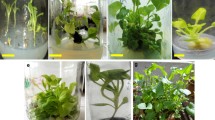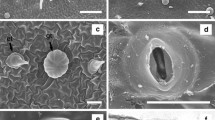Abstract
The effects of stock-plant etiolation on coppice-shoot growth, drifts in total soluble sugars and anthraquinones (AQs; C14H8O2), and rooting potentiality of shoot cuttings were examined in Tectona grandis L. f. (clone FG1). When seedlings were one-year-old, they were coppiced and maintained in the dark for etiolation, with a parallel set kept under natural light in an open environment. Coppice shoots were made into single-node leafy cuttings (SNCs), which were cultured under intermittent mist for rooting. These SNCs were treated with different concentrations of NAA (0, 2000 and 3000 mg l−1). Etiolation significantly increased the coppice-shoot length, internode length, number of coppice shoots, number of leaves, number of nodes and total soluble sugars. The HPTLC analysis showed qualitative and quantitative differences in AQs in coppice shoots obtained from etiolated and non-etiolated stock plants. The study showed that AQs could be used as a marker for maturity and juvenility in teak. Stock-plant etiolation caused a significant increase in percent rooting and sprouting, shoot length, number of shoots and number of leaves per SNC, but a decrease in callusing at the base of the SNC. NAA at 2000 and 3000 mg l−1 had inhibitory effects on rooting and sprouting of SNCs. The result showed that stock-plant etiolation fostered rooting by rejuvenating the coppice shoots.


Similar content being viewed by others
Abbreviations
- AQ:
-
Anthraquinone
- NAA:
-
α-naphthaleneacetic acid
- HPTLC:
-
High performance thin layer chromatography
- SNC:
-
Single-node leafy coppice-shoot cutting
References
Abel S, Nguyen MD, Chow W, Theologis A (1995) ACS4, a primary indoleacetic acid-responsive gene encoding 1-aminocyclopropane-1-carboxylate synthase in Arabidopsis thaliana—characterization, expression in E. coli, and expression characteristics in response to auxin. J Biol Chem 270:19093–19099
Amo-Marco JB, Vidal N, Vietez AM, Ballester A (1993) Polypeptide markers differentiating juvenile and adult tissues in Chestnut. J Plant Physiol 142:117–119
Bon MC (1988) J 16: an apex protein associated with juvenility of Sequoiadendron giganteum. Tree Physiol 4:381–387
Brown DE, Rashotte AM, Murphy AS, Normanly J, Tague BW, Peer WA, Taiz L, Muday GK (2001) Flavonoids act as negative regulators of auxin transport in vivo in Arabidopsis. Plant Physiol 126:524–535
Buer CS, Muday GK (2004) The transparent testa4 mutation prevents flavonoid synthesis and alters auxin transport and the response of Arabidopsis roots to gravity and light. Plant Cell 16:1191–1205
Cao XF, Linstead P, Berger F, Kieber J, Dolan L (1999) Differential sensitivity of epidermal cells is involved in the establishment of cell pattern in the Arabidopsis root. Physiol Plant 106:311–317
Dubois M, Gillies KA, Hamilton JK, Rebers PA, Smith F (1956) A colorimetric method for determination of sugars and related substances. Anal Chem 28:350–356
Fett-Neto AG, Fett JP, Veira Goulart LW, Pasquali G, Termignoni RR, Ferreira AG (2001) Distinct effects of auxin and light on adventitious root development in Eucalyptus saligna and Eucalyptus globulus. Tree Physiol 21:457–464
Haissig BE (1986) Metabolic process in adventitious rooting of cuttings. In: Jackson MB (ed) New root formation in plants and cuttings. Martinus Nijhoff, Dordrecht, Boston, Lancaster, pp 141–189
Haissig BE (1990) Reduced irradiance and applied auxin influence carbohydrate relation in Pinus banksiana cuttings during propagation. Physiol Plant 78:455–461
Haissig BE, Davis TD (1994) A historical evaluation of adventitious rooting research to 1993. In: Davis TD, Haissig BE (eds) Biology of adventitious root formation. Plenum Press, New York, London, pp 275–331
Hand P, Besford RT, Richardson CM, Peppitt SD (1996) Antibodies to phase related proteins in juvenile and mature Prunus avium. Plant Growth Regul 20:25–29
Hartmann HT, Kester DE, Davies FT, Geneve RL (1997) Plant propagation—principle and practices. 6th edn. Prentice-Hall of India Private Limited, New Delhi
Husen A (2002) Physiological effects of phytohormones and mineral nutrients on adventitious root formation and clonal propagation of Tectona grandis Linn. f. Ph.D. Dissertation, Forest Research Institute
Husen A (2004) Clonal propagation of Dalbergia sissoo Roxb. by softwood nodal cuttings: effects of genotypes, application of IBA and position of cuttings on shoots. Silvae Genet 53:50–55
Husen A, Pal M (2003) Effect of serial bud grafting and etiolation on rejuvenation and rooting cuttings of mature trees of Tectona grandis Linn. f. Silvae Genet 52:84–88
Husen A, Pal M (2006) Variation in shoot anatomy and rooting behaviour of stem cuttings in relation to age of donor plants in teak (Tectona grandis Linn. f.). New Forest 31:57–73
Husen A, Pal M (2007a) Metabolic changes during adventitious root primordium development in Tectona grandis Linn. f. (teak) cuttings as affected by age of donor plants and auxin (IBA and NAA) treatment. New Forest 33:309–323
Husen A, Pal M (2007b) Effect of branch position and auxin treatment on clonal propagation of Tectona grandis Linn. f. New Forest (in press). DOI 10.1007/s11056-007-9050-y
Leakey RRB (1985) Capacity for vegetative propagation in trees. In: Cannel MGR, Jackson J (eds) Attributes of trees as crop plants. Institute of Terrestrial Ecology, Monkswood, Huntingdon, pp 110–133
Ludwig-Müller J, Vertocnik A, Town CD (2005) Analysis of indole-3-butyric acid-induced adventitious root formation on Arabidopsis stem segments. J Exp Bot 56:2095–2105
Maynard BK, Bassuk NL (1986) Etiolation as a tool for rooting cuttings of difficult-to-root woody plants. Comb Proc Int Plant Prop Soc 36:488–495
Maynard BK, Bassuk NL (1988) Etiolation and banding effects on adventitious root formation. In: Davis TD, Haissig BE, Sankhla N (eds) Adventitious root formation by cuttings. Dioscorides Press, Portland, pp 29–46
Mellerowich EJ, Riding RT, Greenwood MS (1995) Nuclear and cytoplasmic changes associated with maturation in the vascular cambium of Larix laricina. Tree Physiol 15:443–449
Newton AC, Dick JMcP, McBeath C, Leakey RRB (1996) The influence of R:FR ratio on the growth, photosynthesis and rooting ability of Terminalia spinosa Engl. and Triplochiton scleroxylon K. Schum. Ann App Biol 128:541–556
Niemi K, Julkunen-Tiitto R, Tegelberg R, Haggman H (2005) Light sources with different spectra affect root and mycorrhiza formation in Scots pine in vitro. Tree Physiol 25:123–128
Pal M (1978) Physiological and biochemical effects of seasonal changes in stem cuttings in relation to rooting. Ph.D. Dissertation, Punjab University
Pal M (1980) Vegetative propagation of teak by rooting stem cuttings. Proc Sec Forest Conf 2:145–148
Rey M, Tiburcio AF, Diaz-Sala C, Rodriguez R (1994) Endogenous polyamine concentration in juvenile, adult and in vitro reinvigorated hazel. Tree Physiol 14:191–200
Sawhney V, Shoesran IS, Kaur A, Singh R (1968) Effects of nitrate application on nitrogen fixation and nodule metabolism in cajanus. Plant Physiol Biochem 26:753–759
Sorin C, John DB, Camus I, Ljung K, Kowalczyk M, Geiss G, McKhann H, Garcion C, Vaucheret H, Sandberg G, Bellini C (2005) Auxin and light control of adventitious rooting in Arabidopsis require ARGONAUTE1. Plant Cell 17:1–17
Subramani KK, Vijayakumar N, Farooqi AA, Ramu BS (1996) Influence of season in the biochemical composition and rooting in pre-conditioned stem cuttings of pomegranate (Punica granatum L.) cultivars. Crop Res 11:347–352
Tewari DN (1992) A monograph on teak (Tectona grandis Linn. f.). International Book Distributors, Dehra Dun
Wagner H, Bladt S (1996) Plant drugs analysis: a thin layer chromatography atlas. 2nd edn. Springer-Verlag, Berlin, Heidelberg
Yang S, Hoffman N (1984) Ethylene biosynthesis and its regulation in higher plants. Annu Rev Plant Physiol 35:155–189
Acknowledgments
This work was supported by the World Bank FREE Projects and Indian Council of Forestry Research and Education, Dehra Dun, India. I thank Director and his team (Dr. S. Mahrotra and Dr. Sayyada Khatoon) of National Botanical Research Institute (NBRI), Lucknow, India for providing facilities for HPTLC work.
Author information
Authors and Affiliations
Corresponding author
Rights and permissions
About this article
Cite this article
Husen, A. Stock-plant etiolation causes drifts in total soluble sugars and anthraquinones, and promotes adventitious root formation in teak (Tectona grandis L. f.) coppice shoots. Plant Growth Regul 54, 13–21 (2008). https://doi.org/10.1007/s10725-007-9222-y
Received:
Accepted:
Published:
Issue Date:
DOI: https://doi.org/10.1007/s10725-007-9222-y




